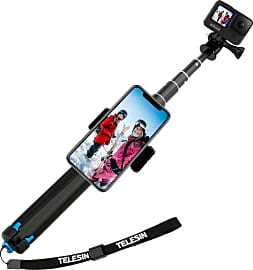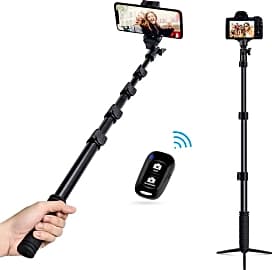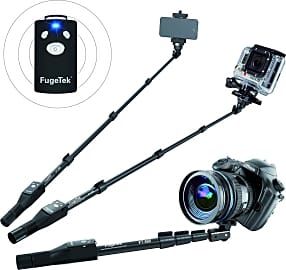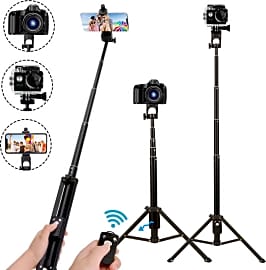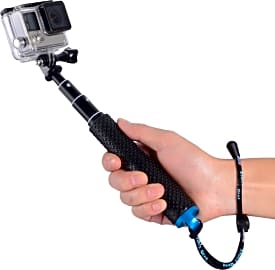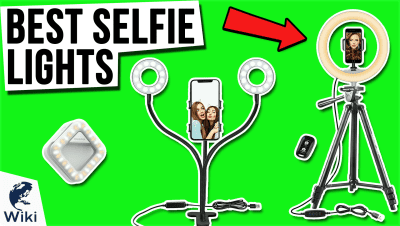The 10 Best Selfie Sticks

This wiki has been updated 40 times since it was first published in May of 2015. Keep yourself in the picture without having to ask another tourist to take the shot (and end up cutting off the top of your head). Our selection of selfie sticks, ranked by ease of use, durability of construction, and cost, will let you insert yourself into any special moment and capture it forever. We've included standard handheld models along with options that double as tripods. When users buy our independently chosen editorial picks, we may earn commissions to help fund the Wiki.
Editor's Notes
December 27, 2020:
Selfie sticks changed the game in how we take pictures of ourselves, and many of the models on this list have taken things a step further by including tripods. Some, like the Yoozon AB402 and Bze 401119, have tripods that are permanently integrated into the handle, while others, such as the Afaith Telesin and UBeesize 2-in-1, feature removable ones that can be screwed on as needed. The former model is also ideal for use with action cameras because it has an attachable phone holder, so you can see exactly what you are filming in real-time on your device's display. When it comes to portability, the extremely lightweight Mpow MBT8 really stands out, while the Trehapuva TRGPST02 is a winner in the ruggedness department.
May 29, 2019:
Gone are the days of begging some random stranger to take photos of you. With one of these handy selfie sticks, you'll have the power to capture stunning shots of yourself at all times. These devices have come a long way since their release, when they were simply sticks you used to hold a phone. Now they come with a range of useful features. For example, the Yoozon WS-SQB645B, Fugetek FT-568, UBeesize 2-in-1, YunTeng Selfie Tripod, BlitzWolf Extendable, and Anker AK-A7 all have removable Bluetooth remotes. Many of these models, such as the Yoozon WS-SQB645B, UBeesize 2-in-1, YunTeng Selfie Tripod, BlitzWolf Extendable, and Anker AK-A7 also feature built-in tripod bases. The Mocreo LED is an interesting offering that features an integrated light and mirror, and the Trehapuva TRGPST02 is waterproof for use with action cams. If you want to be able to get the most amount of background in your shot, your best bet will be the Fugetek FT-568 and YunTeng Selfie Tripod, which offer 49 and 54 inches in length, respectively.
How Old Is The Selfie Stick?
Ninety years after the first known appearance of the selfie, the selfie stick finally caught on.
The original selfies date back to antiquity, with the Renaissance being a period rife with self-portraiture. Of course, this was long before the invention of the camera, but even in the early days of photography, evidence of self portraits exist. Take this 1926 picture as an example. Here you'll see Mr. and Mrs. Hogg, and there's no missing the rigged selfie stick obscuring half the shot.
There's also a Japanese man named Hiroshi Ueda who, in 1983 while working with Minolta, invented a selfie stick for the Disk-7 camera, though it was referred to then as an extender stick. He claims to have come up with the idea after traveling Europe with his wife, where they found it very difficult to get passersby to take their photo.
As you can tell, the idea of the selfie stick has been around arguably longer than photography has, though the means of producing them and getting consumers to latch onto the idea is another story. Even as recently as 2005, Canadian Wayne Fromm invented what he called the Quick Pod, but it would still be nine more years until the mainstream press would take notice.
In 2013, The Oxford Dictionaries named selfie the word of the year. In 2014, TIME named the selfie stick no.18 of the top 25 best inventions of the year. Ninety years after the first known appearance of the selfie, the selfie stick finally caught on.
What You Can Expect Your Selfie Stick To Do
Selfie sticks are really quite genius, and the less-than-exciting explanation of their function goes like this: a selfie stick is a modified monopod comprised of a pole and a clamp to hold a camera, or, more popularly, a smartphone. Typically, they telescope outward, and are thickest at the grip for better balance once the device is attached. Many offer Bluetooth remote controls, built-in shutter buttons, and wrist straps, too, making them simple to transport with you and to set up that perfect shot. From here, the variations are a matter of taste and manufacturer quality.
Depending on your preferences and array of gear, you'll want to lean on the side of customization.
Some selfie sticks are built with smartphones in mind exclusively, whereas others are designed to be compatible with a range of devices including GoPros and DSLR cameras. Depending on your preferences and array of gear, you'll want to lean on the side of customization. Selfie sticks are very straightforward, though there are options that weigh a little more. Some have features like an aluminum body, pivoting head, and tripod attachments. Naturally, these cost more than their basic counterparts.
As far as durability is concerned, many selfie sticks are produced out of aluminum alloy that's not only tough for daily use, but lightweight, as well. And if you're unsure whether you would benefit better from a Bluetooth or wired connection, consider this: Bluetooth may sound like the more high-tech and obvious option, but this requires charging the unit; corded counterparts are always ready to go.
At the end of the day, it's all about allowing a person to hold their camera at a distance far enough away to get themselves in the frame. Finally, the masses can create their own high-quality self portrait with only a smartphone and a selfie stick held high enough to give a flattering angle. And let's face it, people love self-portraits.
Finding The Right Camera Mount
A selfie stick is nothing without its mount. This is what's positioned at the top of the stick, which holds the smartphone or other device in place. The most important responsibility of the consumer is to ensure that their device is compatible with the mount, as they vary from one manufacturer to another - it is, after all, one of the main aspects that sets them apart.
Don't get us wrong - selfie sticks are durable, but they have a weight limit, too.
Many selfie sticks feature a ball head with a 1/4-20 screw to accommodate cameras with the same tripod thread size. It is wise to consider the weight of the device you want to attach; if it's too heavy, typically over two pounds, it will place too much pressure on the stick, which could render it impossible for the user to hold up, and possibly compromise the selfie stick and the camera on the end of it. Don't get us wrong - selfie sticks are durable, but they have a weight limit, too.
There are, however, even simpler units targeted exclusively towards smartphone users. With these types of sticks, you'll find a spring-loaded mount that pulls up for device placement with a rubberized or silicone coating to prevent device damage and ensure a snug fit. They are designed to hold devices at the horizontal position, though some, but not all, have mounts that are able to pivot to the vertical position, or up to 180 degrees.



